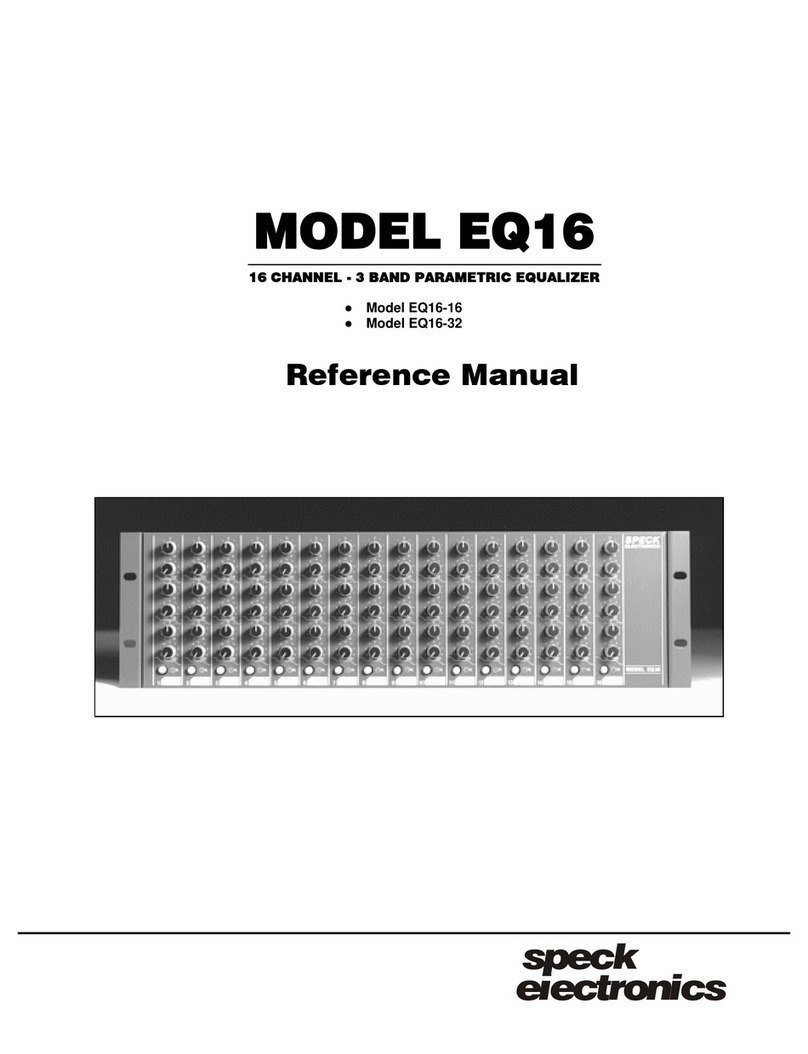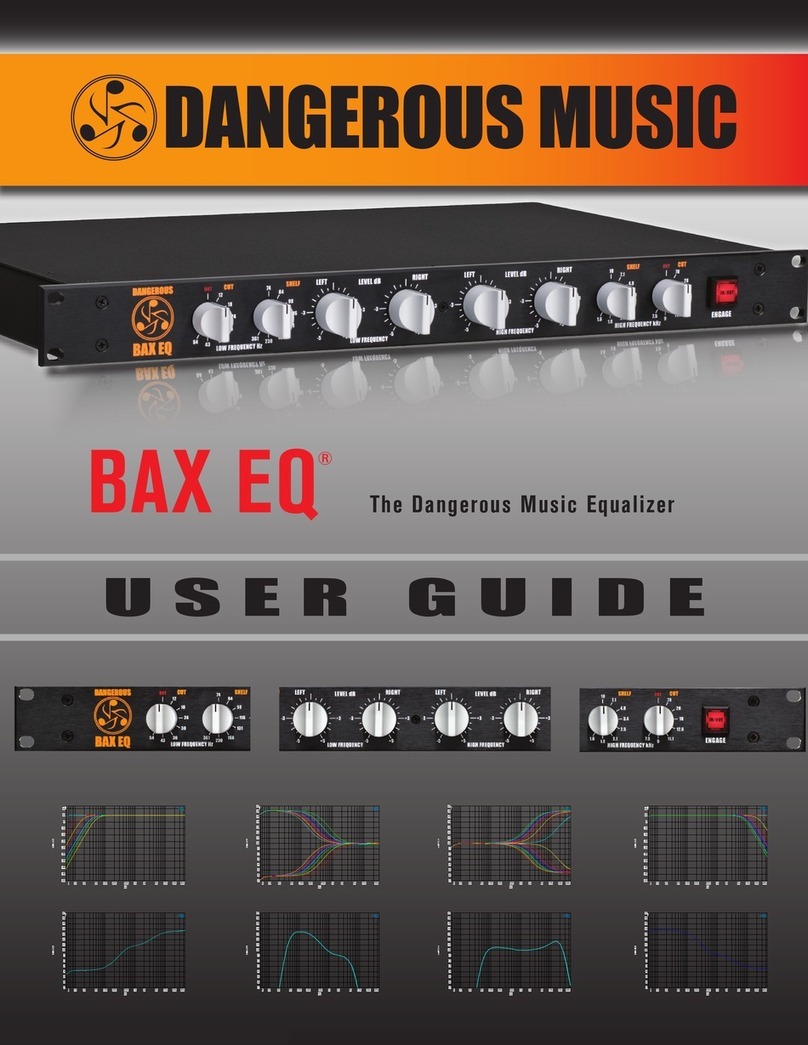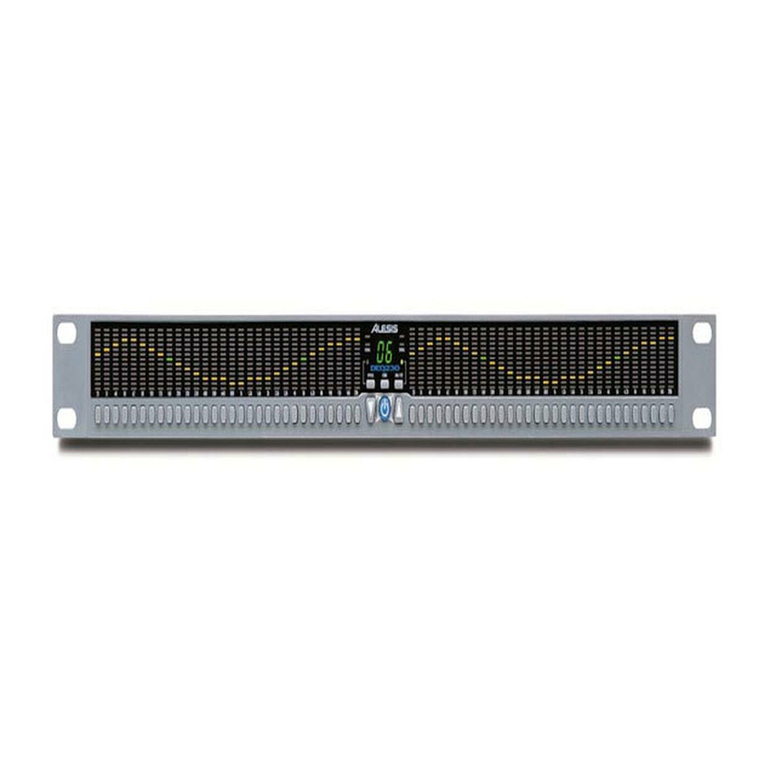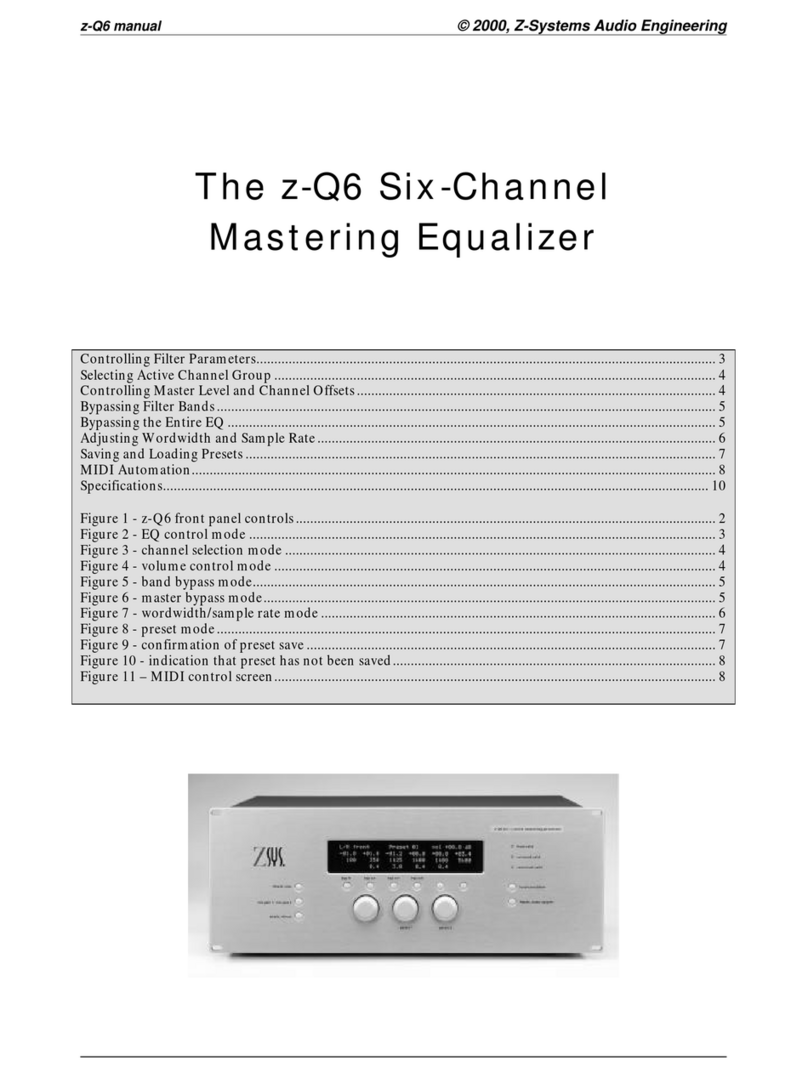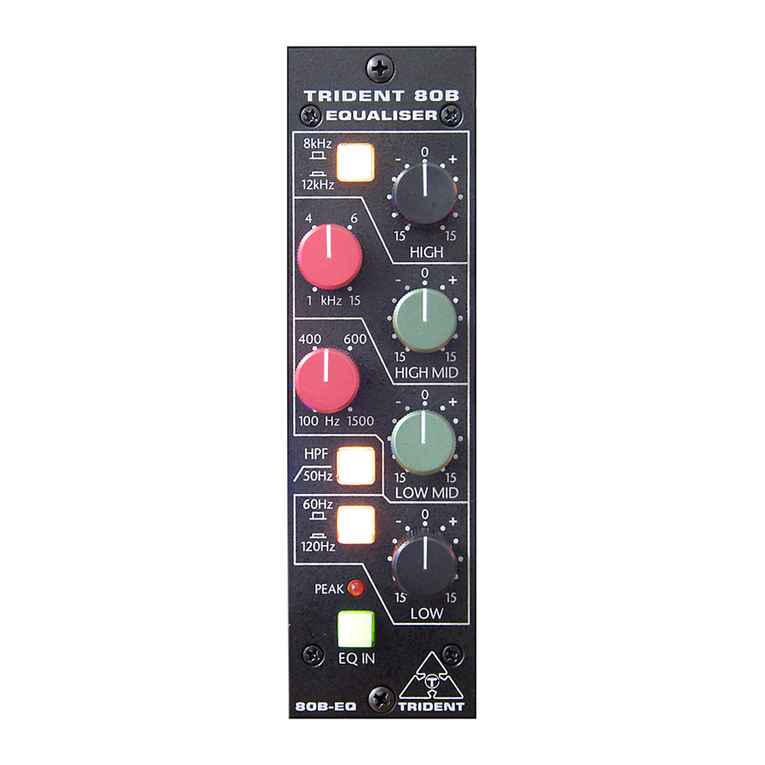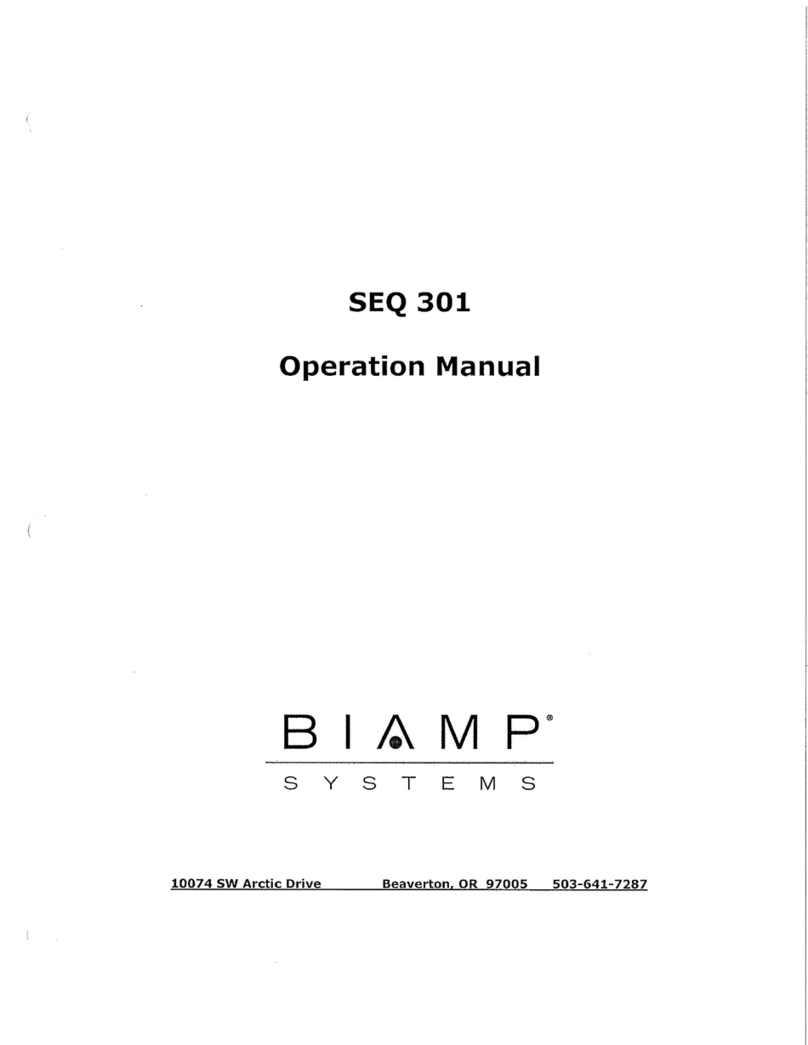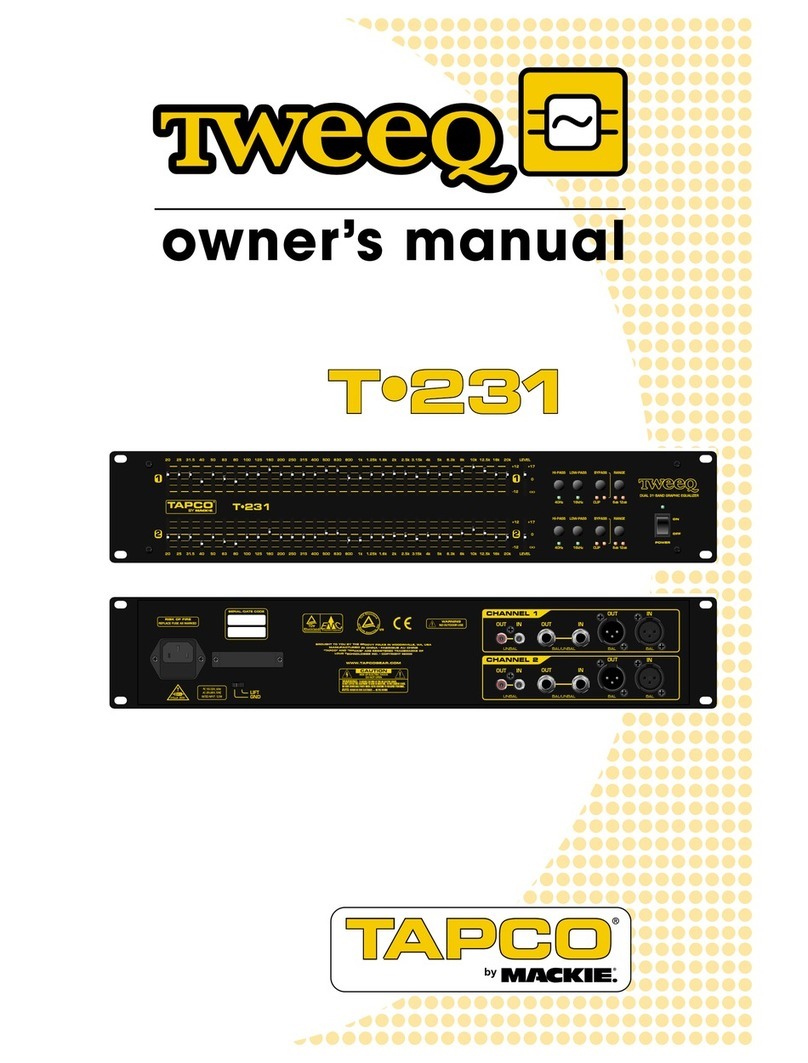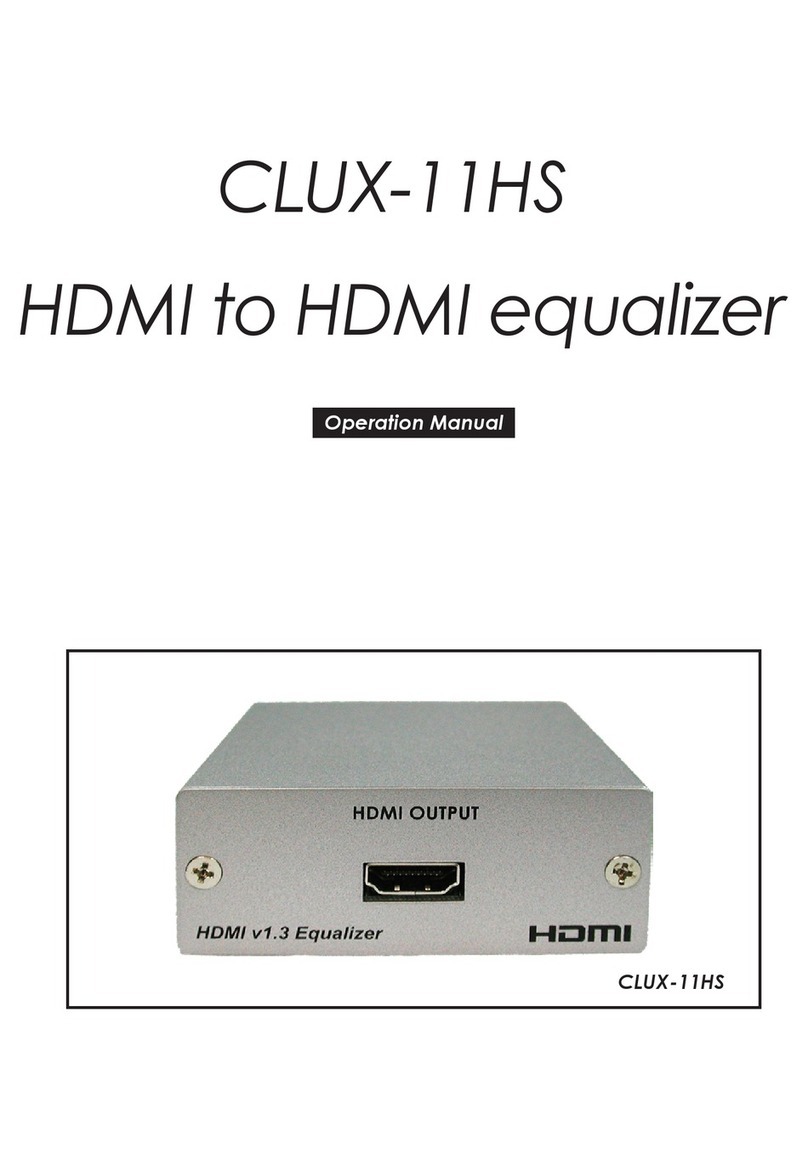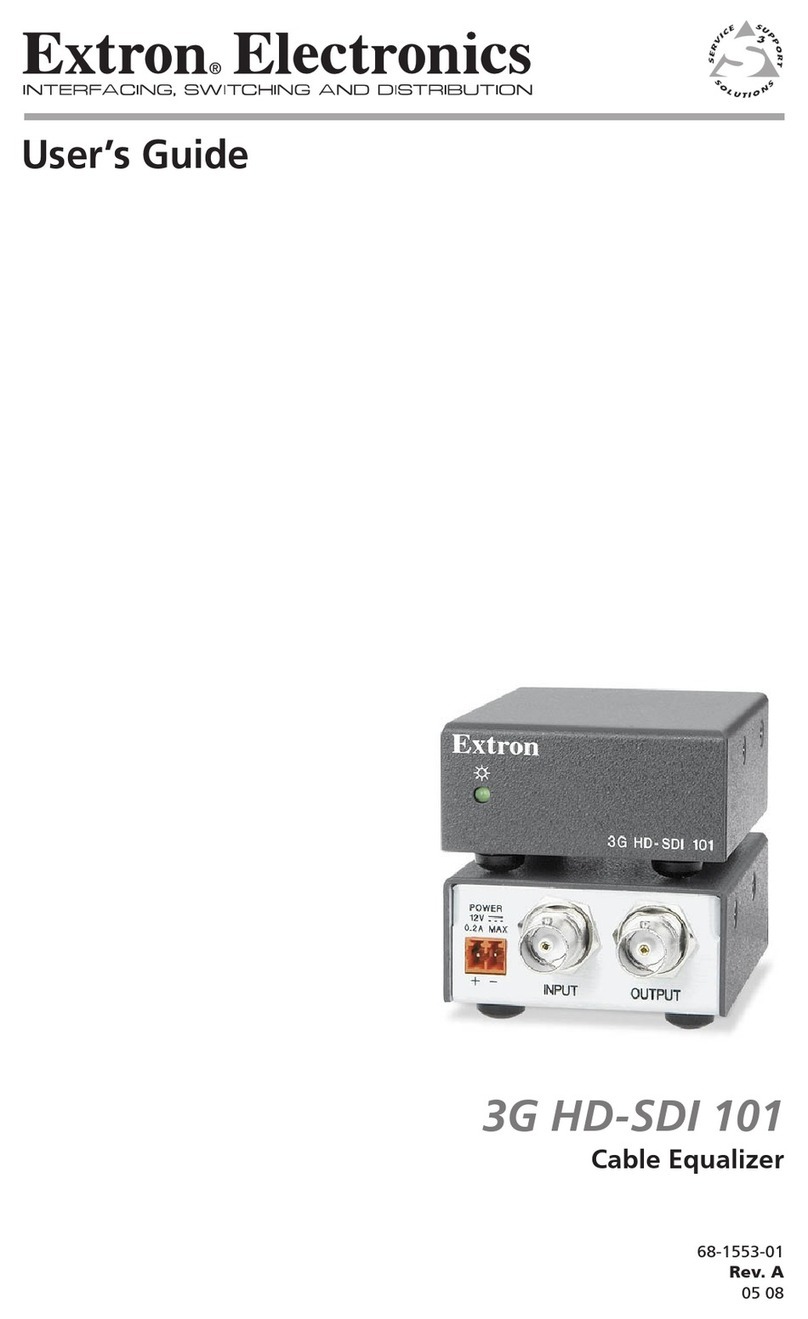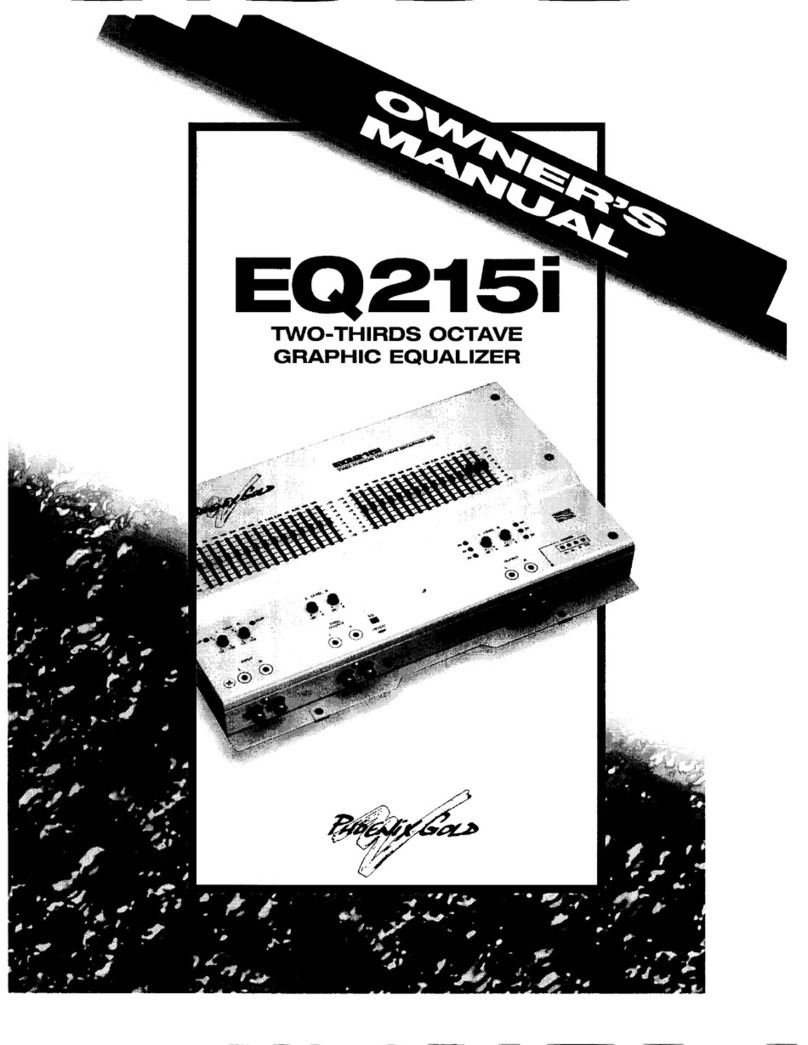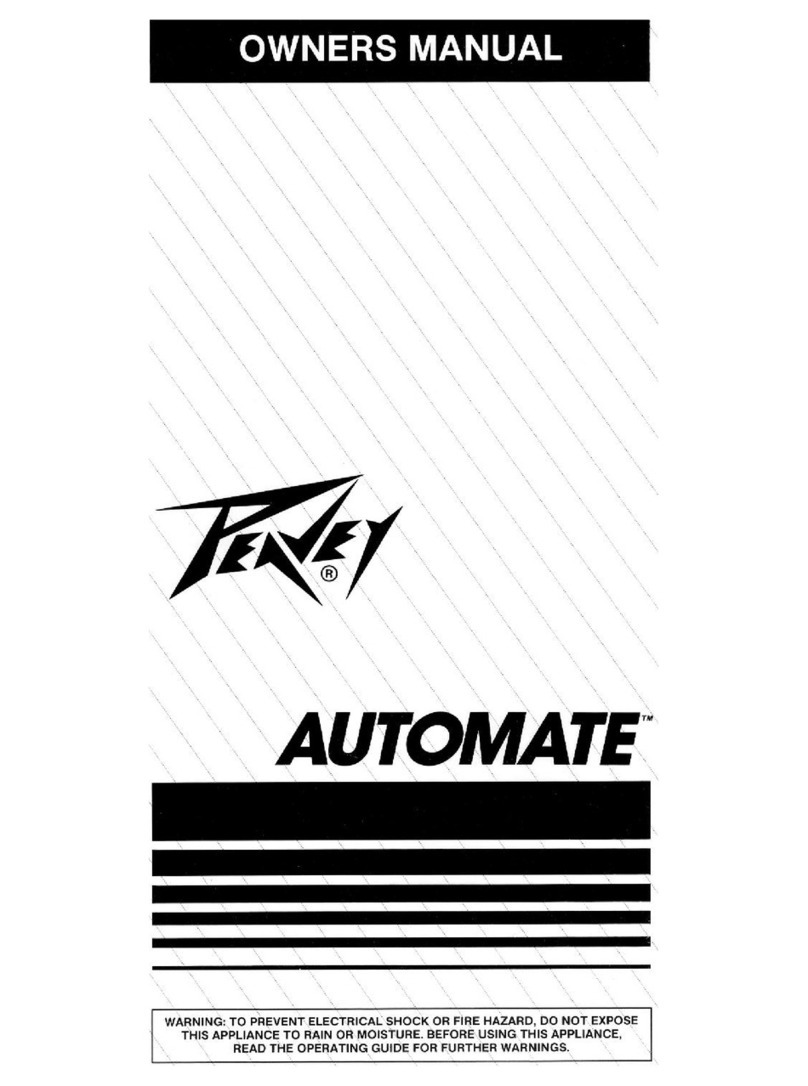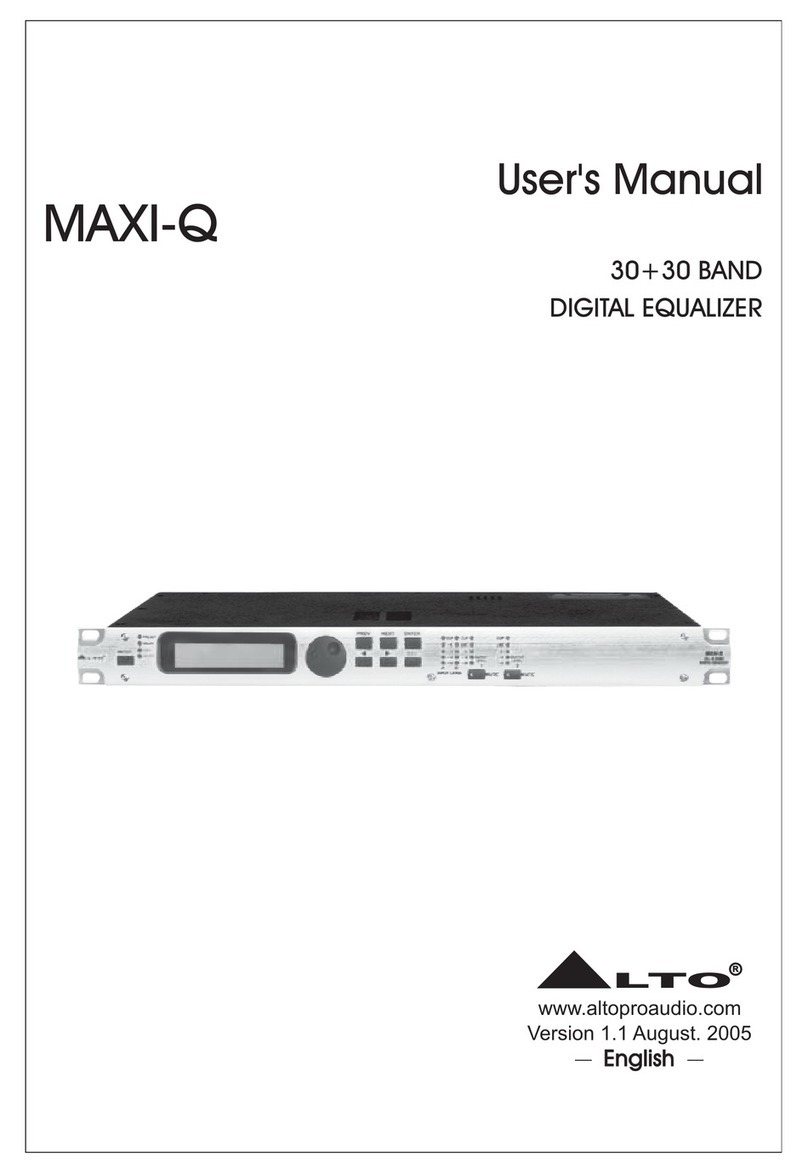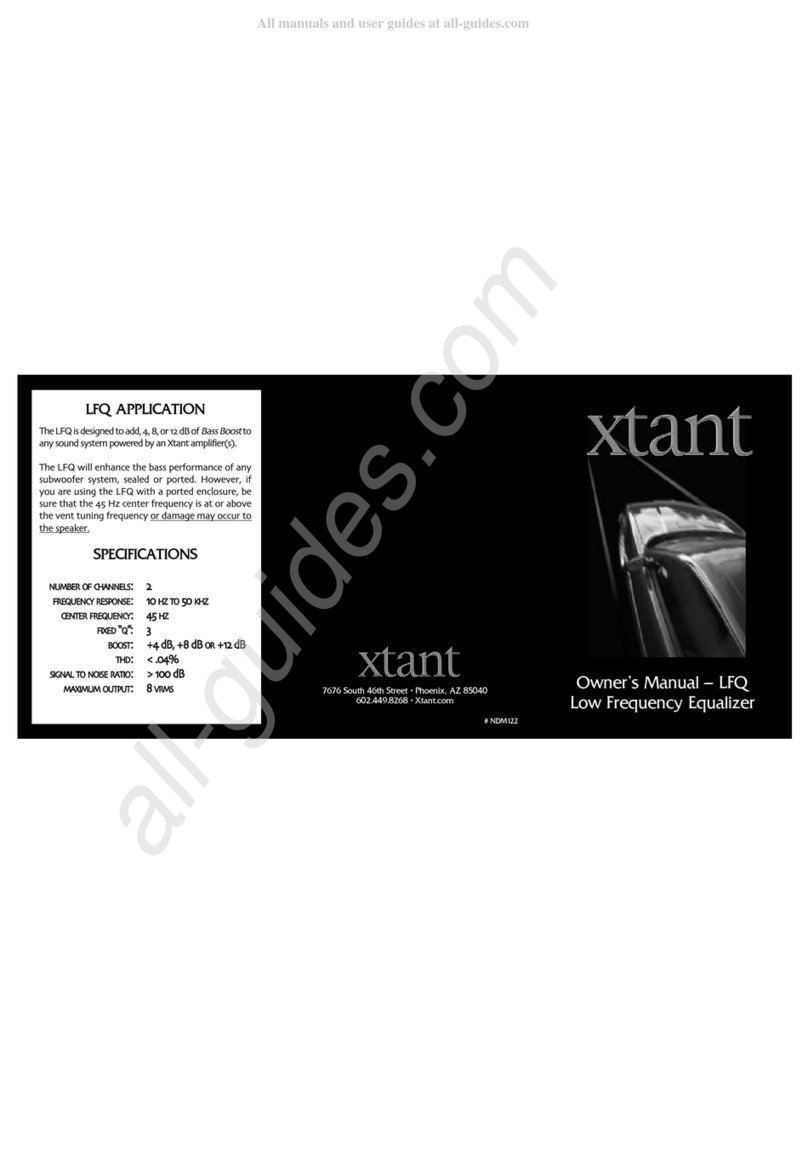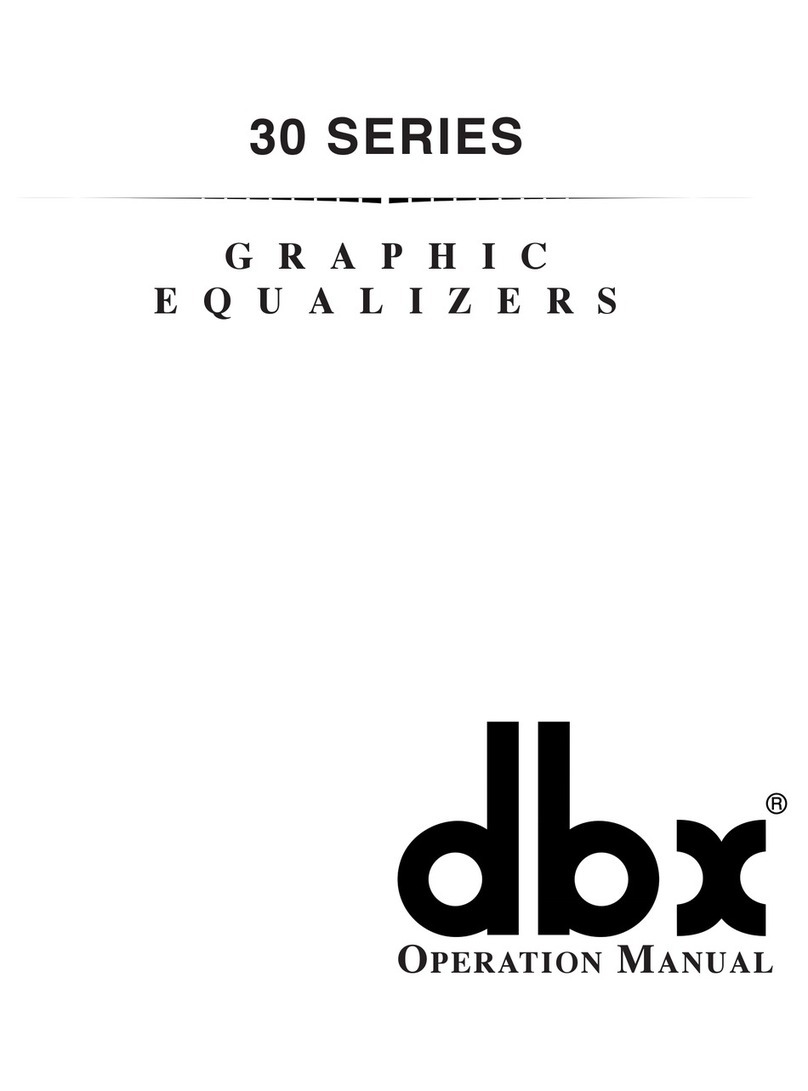Speck EQF 810 User manual

speck electronics
EQF 810
Audio Equalizer
Reference Manual


Speck Electronics products are warranted to the original owner to be free of
defects in material or workmanship.
This warranty does not apply to any product subject to accident, misuse,
neglect, or failure to comply with normal maintenance procedures, or if the
serial number has been defaced, altered, or removed; nor will Speck
Electronics accept responsibility for damages resulting from improper
installation, alteration or unauthorized parts or repairs. If the product is
modified by the customer without permission, the customer agrees to pay for
parts and labor necessary to remove the modification before repair. The cause
of the defect is in the sole judgment of Speck Electronics.
Should a defect develop within one year of purchase from Speck Electronics
or an authorized dealer, Speck Electronics will supply the part or parts
necessary at no charge. Labor is covered in this warranty for a period of one
year. Outside service, repairs, or pickups are not covered under this warranty.
Any item returned for warranty repair should be sent, if possible, in the
original packing container, prepaid to Speck Electronics, 341 E. Alvarado
Street, Fallbrook, California, 92028. If, in our opinion, the packing container
is improper for return shipping, we reserve the right to supply a new container
at a minimal charge.
In the interest of improving Speck products, designs and specifications are
subject to change without notice. It should be mentioned that if a change is
necessary for any reason, we make every effort to document
that change and send an "update notice" to all customers at no charge.
Speck Electronics makes no warranty of any kind with regard to this material,
including, but not limited to, the implied warranties of merchantability and
fitness for a particular purpose. Speck Electronics shall not be liable for
errors contained herein or for incidental consequential damages in connection
with the furnishing, performance, or use of this material.
This document contains proprietary information which is protected by
copyright. All rights are reserved. No part of this document may be
photocopied, reproduced, or translated into another language without the prior
written consent of Speck Electronics.
The information contained in this document is subject to change without
notice.
All trademarks are the property of their respective owners.
Speck Electronic
341 East Alvarado Street
Fallbrook, California 92028
USA
1+760-723-4281
www.speck.com
Warranty
Notice
ii

General .....................................................................
Standard accessories ....................................................
Operator safety summary ...................................................
Power source .............................................................
Removing the cover ....................................................
Specifications ..................................................................
General .....................................................................
Unpacking and inspection ............................................
Environmental considerations .......................................
Grounding the product ..........................................................
Mechanical installation ................................................
Physical placement of adjacent equipment ......................
Cleaning .........................................................................
Repacking for shipment .....................................................
General .....................................................................
Basic Theory of Equalizers ...............................................
Low-pass filter.............................................................
High-pass filter ............................................................
Bandpass filter.............................................................
Default control setting........................................................
Front Panel Controls .......................................................
Output select ...............................................................
Variable filters.............................................................
L - Low band controls ..................................................
L/M - Low/Mid band controls........................................
M - Mid band controls..................................................
H - High band controls .................................................
Rear Panel .....................................................................
Input connectors ..........................................................
Output Cconnectors .....................................................
A.C. power inlet ..........................................................
Fuse ..........................................................................
Power switch ..............................................................
Main voltage selector switch .........................................
General .................................................................................
Audio cable ..........................................................................
Connectors ...........................................................................
AC Distribution and safety ......................................................
Proper AC grounding ...........................................................
Quality AC system ...............................................................
AC distribution .....................................................................
Clock noise and AC .............................................................
Safety earth connection ........................................................
Audio earth ...........................................................................
Proper Audio Grounding and Shielding .................................
EMI and RFI .............................................................................
Sources of EMI ....................................................................
Reducing EMI ......................................................................
1
2
2
2
2
3
5
5
5
6
6
6
7
7
9
9
9
9
9
10
11
11
11
12
13
14
14
16
16
16
17
17
17
18
19
19
19
19
20
20
20
20
20
21
21
21
22
22
Contents
iii
Chapter 1 Introduction
Chapter 2 Installation
Chapter 3 Operation
Chapter 4 Wiring
and Other

Introduction
General
Thank you for purchasing our EQF 810 Equalizer. The EQF 810 has
operational features that are easy to understand and you should be up
and running in no time. If you have any questions regarding the
EQF 810 or any Speck product, do not hesitate to contact Speck
Electronics.
Speck Electronics
341 E. Alvarado Street
Fallbrook, CA 92028
Phone +760-723-4281
email [email protected]
The EQF 810 is a four band parametric equalizer and two variable
filters housed in a 1/2 rack space chassis that covers the audio spectrum
from a low 20Hz all the way up to 25kHz. It is well suited in audio
applications for professional recording, sound contracting, touring, or
any application where equalization is required.
Connect the EQF 810 to virtually any line level source: balanced,
unbalanced, or mixer inserts. The EQF 810 has high headroom that will
handle balanced signals up to +28dBu.
The EQF 810 design uses I.C. operational amplifiers for the active
electronics. All equalizer bands use state variable filter topologies and
the variable filters use a 2nd order Butterworth design. The line inputs
are active-balanced and the outputs are switchable between active-
balanced or Jensen Transformer-balanced.
The EQF 810 is available in 2 versions;
• The Model EQF 810-NA designed to operate with 100 and 120
VAC mains power.
• The Model EQF 810-EU that is designed to operate with 220, 230
or 240 VAC mains power.
Chapter 1 Introduction Section 1

The EQF 810 is supplied with the following list of accessories:
• Operations Manual
• Power cord (North American version only)
• (4) rubber bumpers - used for table top mounting or stacking
multiple units.
• (3) 6-32 x ½” machine screws - supplied to mount the EQF 810
to an optional rack shelf.
The EQF 810 is intended to operate from an AC power source that
does not apply more than 120 Volts RMS (Model EQF 810-NA) or
240 Volts RMS (Model EQF 810-EU) between the supply conductors.
Always make certain that the power cord matches the operating
voltage shown on the rear panel.
To avoid personal injury, do not remove the top cover of the EQF 810
and never operate without the cover panel properly installed. If it
becomes necessary to remove the cover panel for service or to change
the mains operating voltage, always disconnect the power cable
before proceeding.
The EQF 810, with its internal power supply, contains voltages that
can cause serious injury or death. Refer all repairs to a qualified
service technician, or directly to Speck Electronics.
Operator Safety
Summary
Do not remove
covers or panels
Standard accessories
Power source
Chapter 1 Introduction Section 2

Frequency Response
Input Level
Normal
+4 dBu
Maximum
+28dbu
Output Distortion(THD+n)
22Hz to 22KHz @ +4dBu
.0016%
Test Conditions:
AP balanced +4dBu signal connected to input.
All Boost/Cut controls set to “0”
LP and HP filters enable switches set “out”
4 Band EQ enable switch set “in”
AP analyzer connected at output
Residual Noise Measurement
Test Conditions:
AP balanced signal connected to input.
AP Generator set “Off”
All Boost/Cut controls set to “0”
AP analyzer connected at output
Power requirements 9 Watts
Dimensions HxWxD = 8.6" x 1.75" x 11"
(218mm x 44mm x 280mm)
Shipping weight Approximately 7 lbs (3.2Kg)
ALL MEASUREMENTS WERE PERFORMED WITH AN AUDIO PRECISION TEST SET .
Output Level:
(Active Balanced)
(Transformer Balanced)
Normal
+4 dBu
+4 dBu
Maximum
+28dbu
+24dBu
Input Impedance 30K Ohms
Output Impedance
(Active Balanced)
(Transformer Balanced)
60 Ohms
600 Ohms
Measured at active balanced output
Measured at transformer output
5Hz(-0.25dB) to 68kHz(-0.5dB)
2Hz(-.25dB) to 149kHz(-3dB)
10Hz(-0.25dB) to 68kHz(-0.5dB)
10Hz(-.25dB) to 148kHz(-3dB)
Residual Noise Measurement
(10Hz-80kHz)
-89 dBu
Specifications
(Active Balanced)
(Transformer Balanced) .0025%
Shelf switches set “out”
LP filter, HP filters, and Equalizer enable switches set “in”
Shelf switches set “out”
Transformer - Active output switch set “out”
Chapter 1 Introduction Section 3

~ This page left intentionally blank ~
Chapter 1 Introduction Section 4

Installation
The following information should give you the basics on how to install
the EQF 810. The proper installation of the EQF 810 as part of a larger
system requires a clear understanding of audio wiring, AC distribution,
grounding, and shielding techniques.
When the EQF 810 is being installed into a larger system, it may be
necessary to retain the services of someone experienced in these
matters.
The EQF 810 is delivered in a special, protective shipping container
and was carefully inspected both mechanically and electrically before
shipment. It should be physically free of mars and scratches and in
perfect electrical order upon receipt. To confirm this, the product
should be inspected for physical damage that may have occurred in
transit. Any damage should be reported to your dealer or delivery
company as soon as possible.
If installed in an equipment rack that also contains heat producing
equipment, adequate ventilation should be provided. This will prolong
component life and maximize operational stability.
To insure adequate airflow around the unit and to prevent overheating,
do not obstruct the air vents on the side and top.
While the internal circuitry of the EQF 810 is fully shielded by the steel
chassis, installation should nevertheless be planned to avoid locating it
immediately adjacent to power amplifiers, power supplies, or any
source of low frequency electromagnetic emissions.
General
Unpacking and inspection
Environmental considerations
Chapter 2 Installation Section 5

The ground pin of the power cord and power inlet are internally
connected to the chassis. To avoid electrical shock, plug the EQF 810
into a properly wired AC receptacle. For safety reasons, do not lift the
ground on the power plug by using a ground lift adapter.
Upon loss of a protective ground connection, all accessible conductive
parts, including knobs and controls that may appear to be insulating,
can render an electric shock.
The location of the EQF 810 should be such that the operator has a
clear, unobstructed view of the front panel from his/her normal
operating position. The unit should also be within easy reach of the
operators normal position in order to facilitate the use of the front panel
controls
The ½ rack form factor of the EQF 810 allows a single unit to be
mounted on a table top with the (4) rubber bumpers (supplied), multiple
units stacked, or two units mounted side-by-side on a 1U rack shelf.
1 rack space (1U) rack shelves are manufactured by:
• Middle Atlantic Products, Model UTR1
• Raxxess, Model UNS1.
When attaching the EQF 810 to the rack shelf, it should be secured with
(3) 6-32 x ½” machine screws (supplied). Do not use screws that are
longer than ½” in length as they could damage the internal circuit
board. When a single or multiple EQF 810’s are mounted to the rack
shelf, they may be installed into any 19" wide equipment rack that uses
standard E.I.A. universal spacing.
Any device that emits a high EMI (Electro Magnetic Interference) or
RFI (Radio Frequency Interference) energy field should be treated with
suspicion. EMI is considered any unwanted signal which adversely
affects the operation of the EQF 810 or the audio system. This subject
is discussed in Chapter 4.
Electronic equipment such as power amplifiers, power supplies, video
monitors, computers, certain synths, and samplers should be located
away from the EQF 810 and its associated audio cables. It may be
necessary to alter the positions of certain equipment that you feel would
cause buzzes or hums in the audio system.
Mechanical installation
Physical placement of
adjacent equipment
Grounding the product
Chapter 2 Installation Section 6

The front and rear panels are a high quality painted surface and the
panel lettering is applied using a silkscreen printing technique.
To clean the front or rear panel, wipe the surface gently using a soft
lint-free cloth to avoid scratching the panel or markings. Paper towels
are not recommended. Commercially available window cleaner
solutions may be used; however, the solution should be applied to the
cloth and not the panel to avoid the seepage of liquid to the inside of the
enclosure.
The following information is provided as a general guide for
repackaging your EQF 810 for shipment. If you have any questions,
contact Speck Electronics at +760-723-4281.
If the product is to be shipped to Speck Electronics for service or repair,
contact Speck Electronics for a Return Merchandise Form. When we
receive the completed form, a RMA number and shipping instructions
will be issued. Place the product in the original container if available.
If the original container is not used, wrap the product in heavy plastic
before placing in an inner container. Use plenty of packing material
around all sides of the product and protect panel faces with cardboard
strips. Mark shipping container with "Delicate Instrument" or
"Fragile," and insure the shipment for the proper amount.
Note: Speck Electronics cannot be responsible for equipment that
arrives damaged or uninsured.
Cleaning
Repacking For
Shipment
Chapter 2 Installation Section 7

~ This page left intentionally blank ~
Chapter 2 Installation Section 8

We hope to give you basic information on the operation of the EQF 810
and adequately describe its controls, switches, and connectors.
The information in this manual is intended to help with the technical
process when using your equalizer. Words alone could not adequately
describe how to adjust the controls of an equalizer. Your ears should be
your best gauge of how to adjust the equalizer controls to make the
sound fit your requirements.
A parametric equalizer falls into the generic category called a “filter.”
A filter is an electronics circuit that allows signals of certain frequencies
to be transmitted through a system, while preventing the transmission
of other frequency ranges.
There are 3 basic types of passive or active filters; low-pass, high-pass,
and bandpass.
A low-pass filter is a circuit that passes all low frequency signals and
rejects high frequency signals. The crossover point that low
frequencies pass through can be either fixed at a specific point or
variable.
A high-pass filter is a circuit that passes all high frequency signals and
rejects low frequency signals. The crossover point that high
frequencies pass through can be either fixed at a specific point or
variable.
A bandpass filter is a circuit that will pass only a fixed frequency band
and reject signals above and below the selected band.
A parametric equalizer is a very elaborate bandpass filter that offers the
ability to control the filter's basic parameters - hence the term
“Parametric Equalizer.” These controllable parameters are the
bandpass center frequency, the amplitude of the bandpass frequency,
and the width of the bandpass frequency. These previously mentioned
parameters as found on audio parametric equalizers are commonly
known as the sweep control, boost/cut control, and bandwidth (Q)
adjust respectively.
The EQF 810 equalizer utilizes all the previously mentioned parametric
controls.
Operation
Basic Theory
of Equalizers
General
Low-pass filter
High-pass filter
Bandpass filter
Chapter 3 Operation Section 9

Before any attempt is made to operate the EQF 810, it would be a good
idea to set all the controls to their neutral positions. This gives you a
reference point to work from when adjusting controls and switches.
All “Frequency Sweep” and “Bandwidth” controls should be set to their
full counter-clockwise setting. All “Boost/Cut” controls should be set
to their "0" center detented position. All pushbutton switches should be
set to the "Out" position.
When any future reference is made to the controls or switches of the
EQF 810, will be assumed that they have been set to their neutral
positions.
Default Control Settings
Chapter 3 Operation Section 10

FRONT PANEL CONTROLS
This switch will select either a “Transformer-
Balanced” or “Active-Balanced” output for the XLR
and 1/4” TRS outputs.
A dual colored LED will illuminate indicating that the
EQF 810 is powered and active. When the output
switch is set to the “XFMR” position, the LED will
indicate green. This LED will change from green to
red when the switch is depressed to the “ACTIVE”
position.
This control adjusts the frequency of the HP filter from 20Hz (Full
CCW) to 250Hz (Full CW) with a slope of 12dB/octave for the low
range selection or 100Hz to 1.2kHz when the 5X select switch is
enabled.
This switch is used to enable or disable the High
Pass filter circuit. In the “out” position, this switch
completely bypasses the HP filter circuitry. When
this switch is depressed, the HP filter is enabled.
A green LED indicates the operation of the filter.
This switch selects the frequency range of the high
pass filter. In the “out” position, the low range of
20Hz-250Hz is selected. When depressed, this
switch selects a range of 100Hz-1.2kHz. A yellow
LED illuminates indicating that the 5X frequency
multiplier has been enabled.
This control adjusts the frequency of the LP filter
from 150Hz (Full CCW) to 25kHz (Full CW) with
a slope of 12dB/octave.
This switch is used to enable or disable the Low Pass filter circuit. In
the “out” position, this switch completely bypasses the LP filter
circuitry. When this switch is depressed, the LP filter is enabled. A
green LED indicates the operation of the filter.
1. Output Select
VARIABLE FILTERS
2. High Pass Frequency
5. Low Pass Frequency
3. High Pass Filter Enable
6. Low Pass Filter Enable
4. High Pass X5 select
1
2
34
56
Chapter 3 Operation Section 11

This switch is used to enable or disable the 4 band equalization circuit.
In the “out” position, all equalizer bands are bypassed. When in the
bypass position, the active balanced input stage, the active balanced
output stage, and the transformer remains operational. This allows the
levels to match when comparing the equalized signal to the unequalized
signal. A green LED indicates the operation of the equalizer.
The low frequency sweep control is used in conjunction with the low
boost/cut control and provides continuous
adjustment of the center frequency from 20Hz
(fully counterclockwise) to 400Hz (fully
clockwise). The Bandwidth (Q) of the low band
is fixed at 1 octave (Q=1.0)
The boost/cut control provides a reciprocal
volume adjustment of the selected frequency
control. This means that whatever frequency is
“boosted” with the boost/cut adjusted from its
center position clockwise, an identical but
opposite result is achieved when that same
frequency selection is “cut” from its center
position counterclockwise. Once the desired
frequency has been selected with the low
frequency sweep control, that frequency may be
continuously accentuated or attenuated (boost or
cut) from 0 to +15dB or -15dB. 0dB (flat) is obtained when this control
is set to its center detented position.
This switch changes the low frequency band from a peak/dip curve (as
shown in Figure 1a) to shelving curve (as shown in Figure 1b).
.
8. Low frequency sweep
7. Equalizer bypass switch
Fig. 1a. Shelving Curve
Fig. 1b. Peak/Dip Curve
9. Low boost/cut
10. Peak/Shelf Switch
L (Low) BAND
7
8
9
10
Chapter 3 Operation Section 12

The low/mid frequency sweep control is used in conjunction with its
respective boost/cut control and provides continuous adjustment of the
center frequency from 40Hz (fully counterclockwise) to 800Hz (fully
clockwise) for the low range selection or 400Hz (fully
counterclockwise) to 8kHz (fully clockwise) for the mid range
selection.
This switch selects the frequency range of the Low/Mid band. In the
“out” position, the low range of 40Hz-800Hz is selected. When
depressed, this switch selects the mid band of 400Hz-8kHz. A yellow
LED illuminates indicating that the 10X frequency multiplier has been
enabled.
This control provides 15dB of bell shaped
boost or cut for the Low/Mid band frequency
range, and is used in conjunction with the
Low/Mid frequency sweep adjust. 0dB (flat)
is obtained when this control is set to its
center detented position.
For the Low/Mid band, a continuously
adjustable bandwidth control is provided.
This control sets the width of the frequency
that has been selected on the Low/Mid
sweep control. When set fully CCW, the
bandwidth is a wide 2.25 octaves (Q=.45).
When set fully CW, the bandwidth narrows
to .22 octave (Q=4.4). The center position
is approximately .4 octaves (Q=2.4).
In addition to the ability to contour low band audio, the low frequency
controls may be used to reduce or eliminate low frequency hum or
buzz. Low hum is typically 60Hz, whereas buzz is typically 120Hz and
240Hz. If there is a hum or buzz on an audio track, the low sweep
control and associated boost/cut control can be used to remove this.
To reduce 60Hz hum, start by setting the bandwidth control to its fully
(CW) position, the low frequency sweep control to its fully
counterclockwise (CCW) position; this is about 40Hz. Turn the
Boost/Cut control fully CCW. Return to the frequency sweep control,
and turn clockwise a little until the 60Hz hum has been reduced. This
setting is the 60Hz point. Now go back to the Boost/Cut control and
adjust as necessary.
In some extreme cases, it may be necessary to use both the low band
and the Low/Mid band of equalization in order to remove the
undesirable affects of 60Hz or 120Hz hum.
L/M (Low/Mid) BAND
12. Low/Mid X10 select
11. Low/Mid frequency sweep
13. Low/Mid Boost and cut
14. Low/Mid bandwidth adjust
11
12 13
14
Chapter 3 Operation Section 13

The mid frequency sweep control is used
in conjunction with the mid boost/cut
control and provides continuous
adjustment of the center frequency from
400Hz (fully counterclockwise) to 10KHz
(fully clockwise).
This control provides 15dB of bell shaped
boost or cut for the Mid band (400Hz to
10kHz) frequency range, and is used in
conjunction with the high frequency sweep
adjust. 0dB (flat) is obtained when this
control is set to its center detented
position.
For the Mid band, a continuously adjustable bandwidth control is
provided. This control sets the width of the frequency that has been
selected on the Mid sweep control. When set fully CCW, the
bandwidth is a wide 2.25 octaves (Q=.45). When set fully CW, the
bandwidth narrows to .22 octave (Q=4.4). The center position is
approximately .4 octaves (Q=2.4).
The high frequency sweep control is used in
conjunction with the high boost/cut control
and provides continuous adjustment of the
center frequency from 1.5kHz (fully
counterclockwise) to 25kHz (fully
clockwise). The Bandwidth (Q) of the High
band is fixed at 1 octave (Q=1.0)
.
M (Mid) BAND
H (High) BAND
15. Mid frequency sweep
16. Mid boost/cut
17. Mid bandwidth adjust
18. High frequency sweep
15
16
17
18
19
20
Chapter 3 Operation Section 14

This control provides 15dB of bell shaped boost or cut for the high
frequency range (1.5kHz to 25kHz), and is used in conjunction with the
high frequency sweep adjust. 0dB (flat) is obtained when this control is
set to its center detented position.
In addition to the ability to contour high band audio, the high band
controls can reduce hiss that is present on low frequency information. If
there is high frequency hiss or digital noise on a kick drum or bass
track, the high sweep control may be set to its higher clockwise setting
(16kHz-25kHz) and its associated boost/cut control “cut” a few dB's.
As long as you don't dramatically change the sound of the low
frequency audio, this could remove a little noise. Every little bit
improves the overall quality of your sound.
This switch changes the high frequency band from a peak/dip curve (as
shown in Figure 2a) to shelving curve (as shown in Figure 2b).
19. High boost/cut
Fig. 2a. Shelving Curve
Fig. 2b. Peak/Dip Curve
20. Peak/Shelf Switch
Chapter 3 Operation Section 15

Two types of input connectors are available on the EQF 810: a 1/4”
TRS balanced jack and a female XLR connector. These inputs are
internally wired in parallel and identical in every aspect except for the
connector.
The input 1/4” TRS and XLR should not be used at the same time.
The 1/4” jack will accept a balanced TRS plug or a unbalanced mono
TS plug. For unbalanced operation a standard mono plug should be
used.
The output of the EQF 810 has a balanced 1/4” jack and male XLR
connector. These outputs are internally wired in parallel and there is no
operational difference between one or the other. The outputs can be
either “Transformer-Balanced” or “Active-Balanced” depending on the
position of the “Output Select Switch” on the front panel.
The 1/4” TRS and XLR may be used at the same time.
21. Input Connectors
22. Output Connectors
HIGH
LOW
GROUND
PIN 2
PIN 3
PIN 1
HIGH
LOW
GROUND
TIP
RING
SLEEVE
The pin configuration for all ¼” TRS jacks are:
The pin configuration for all XLR connectors are:
22 21
Chapter 3 Operation Section 16
REAR PANEL
Table of contents
Other Speck Stereo Equalizer manuals
